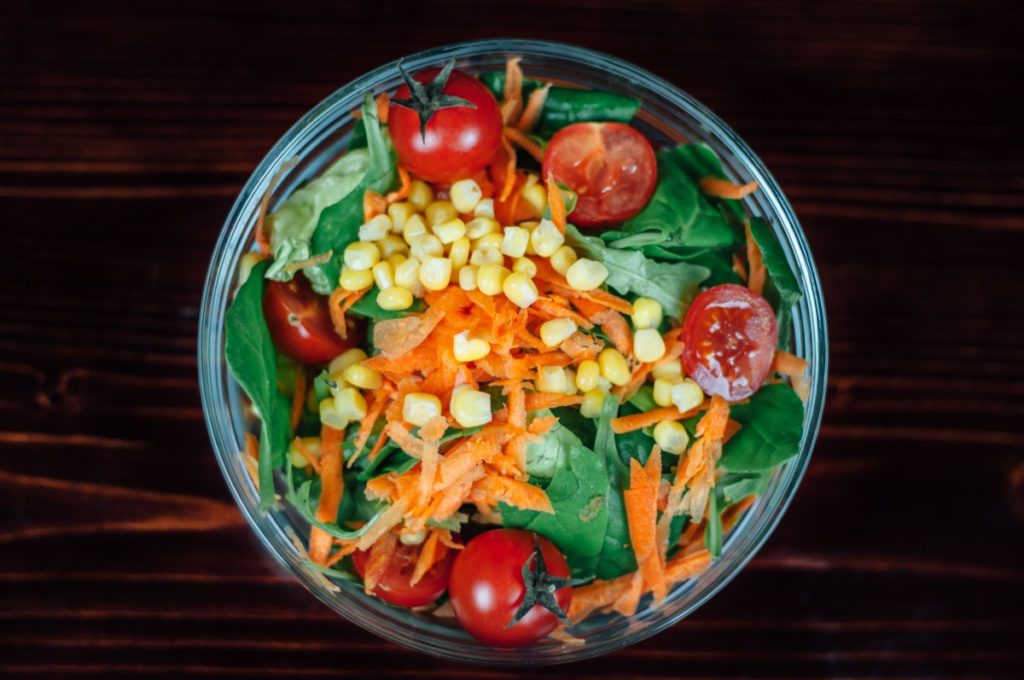Salad days

When I was a teenager, my grandmother would travel from Ohio to visit us in the suburbs of New York. My mother sometimes let me stay home from school — I probably used some vague physical disorder as the excuse — but we knew it was so we could all be together.
For lunch, I would make a salad. Even then, I had a feel for how they are assembled, what goes together and how to dress them. My grandmother called me her ‘Salad Girl,’ a title I still value.
Knowing how to make flavorful, healthy, varied salads is a skill we should all have, and learning to make excellent and healthy home-made dressings is easy and worth the little time it takes. There are also numerous excellent commercial salad dressings on the market.
I know people for whom confronting large amounts of lettuce can feel dispiriting. I hope that following some of the basic approaches below might turn over a whole new leaf for your salad life.
Here’s my 6-category foolproof approach to summer salads. You can choose one or many of the suggestions below in each category.
1. Greens and herbs
Summer greens are ample and varied. Consider some of the less familiar ones such as mizuna, sorrel and mache for surprising tang and flavor. And of course the wonderful array of familiar lettuces: red, green. Romaine and Bibb lettuces, spinach, arugula, cabbage, watercress.
Add chopped fresh herbs to the mix. Dill, cilantro, basil, chives, tarragon, and mint all really enhance the base of greens. Add them together or one by one and discover what a difference they can make.
2. Other vegetables
Be creative with the veggies you add. I like cucumbers, colored peppers, zucchini, tomatoes, sweet onions, radishes and other fresh veggies that grab you. I love cutting corn right off the cob into salads — all the varieties we get are super sweet and don’t need cooking.
3. Fresh or dried fruit
Be creative when you add summer fruits to your salads: mandarins, blueberries, strawberries, peaches, plums and nectarines are all wonderful additions. So are dried cherries, cranberries, dried apricots or dates and figs.
4. Cheese
We have so many choices from crumbled feta or goat cheese, blue cheese or gorgonzola, grated of shredded parmesan or cheddar, even soft cheeses like ricotta or brie.
5. Proteins and Grains
Adding cooked beans — garbanzos or other canned beans, cooked tiny lentils (French or black) — or grains, such as bulgur, barley and farro, are all good for crunch, flavor and health. If you want animal protein, use boiled eggs, canned tuna or salmon, chicken, turkey, bacon, or other deli meats.
6. Toppings (not necessary but fun)
You can always scatter croutons, nuts or seeds or add other finishing flourishes.
Dressings
Basic Balsamic Vinaigrette
Ingredients:
¼ C. Good balsamic vinegar – try some of the flavored ones that are easily found.
¼ C. wine vinegar
2 T. Pomegranate molasses
1 clove garlic, crushed
1 tsp. Dijon or other mustard
¾ C. virgin olive oil
Salt and Pepper
Directions:
Crush garlic and mix with mustard.
Add other ingredients and blend well.
Taste for the right blend of sour with touch of sweetness.
Excellent over hearty salads with lots of elements.
Buttermilk Dressing
Ingredients:
1 C. buttermilk
½ C. yogurt (you can also use good mayonnaise or sour cream)
Juice of 1 lemon
Small clove garlic — smashed but not crushed (so you can take this out later)
½ C. of fresh herbs of your choice: Tarragon, basil, dill, cilantro, chives, mint. Feel free to mix these. They all go well together.
Directions:
Mix all ingredients and use with the whatever salad you’ve assembled.
Will keep for 3-4 days.
Minty Lemon Dressing
Ingredients:
½ C. chopped fresh mint
3 cloves garlic, finely minced or crushed
Juice of 2 lemons
½ C. Virgin olive oil
Salt and Pepper
Directions:
Mix all ingredients and pour over tender greens. Butter lettuce or other soft-leaved greens are good.
Note: You do need to like garlic with this dressing. But remember that the mint takes the bite out of the garlic and the dressing gives a bright fresh feel to the greens.
